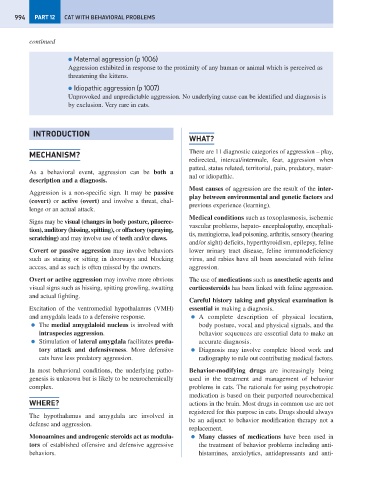Page 1002 - Problem-Based Feline Medicine
P. 1002
994 PART 12 CAT WITH BEHAVIORAL PROBLEMS
continued
● Maternal aggression (p 1006)
Aggression exhibited in response to the proximity of any human or animal which is perceived as
threatening the kittens.
● Idiopathic aggression (p 1007)
Unprovoked and unpredictable aggression. No underlying cause can be identified and diagnosis is
by exclusion. Very rare in cats.
INTRODUCTION
WHAT?
There are 11 diagnostic categories of aggression – play,
MECHANISM?
redirected, intercat/intermale, fear, aggression when
patted, status related, territorial, pain, predatory, mater-
As a behavioral event, aggression can be both a
nal or idiopathic.
description and a diagnosis.
Most causes of aggression are the result of the inter-
Aggression is a non-specific sign. It may be passive
play between environmental and genetic factors and
(covert) or active (overt) and involve a threat, chal-
previous experience (learning).
lenge or an actual attack.
Medical conditions such as toxoplasmosis, ischemic
Signs may be visual (changes in body posture, piloerec-
vascular problems, hepato- encephalopathy, encephali-
tion), auditory (hissing, spitting), or olfactory (spraying,
tis, meningioma, lead poisoning, arthritis, sensory (hearing
scratching) and may involve use of teeth and/or claws.
and/or sight) deficits, hyperthyroidism, epilepsy, feline
Covert or passive aggression may involve behaviors lower urinary tract disease, feline immunodeficiency
such as staring or sitting in doorways and blocking virus, and rabies have all been associated with feline
access, and as such is often missed by the owners. aggression.
Overt or active aggression may involve more obvious The use of medications such as anesthetic agents and
visual signs such as hissing, spitting growling, swatting corticosteroids has been linked with feline aggression.
and actual fighting.
Careful history taking and physical examination is
Excitation of the ventromedial hypothalamus (VMH) essential in making a diagnosis.
and amygdala leads to a defensive response. ● A complete description of physical location,
● The medial amygdaloid nucleus is involved with body posture, vocal and physical signals, and the
intraspecies aggression. behavior sequences are essential data to make an
● Stimulation of lateral amygdala facilitates preda- accurate diagnosis.
tory attack and defensiveness. More defensive ● Diagnosis may involve complete blood work and
cats have less predatory aggression. radiography to rule out contributing medical factors.
In most behavioral conditions, the underlying patho- Behavior-modifying drugs are increasingly being
genesis is unknown but is likely to be neurochemically used in the treatment and management of behavior
complex. problems in cats. The rationale for using psychotropic
medication is based on their purported neurochemical
WHERE? actions in the brain. Most drugs in common use are not
registered for this purpose in cats. Drugs should always
The hypothalamus and amygdala are involved in
be an adjunct to behavior modification therapy not a
defense and aggression.
replacement.
Monoamines and androgenic steroids act as modula- ● Many classes of medications have been used in
tors of established offensive and defensive aggressive the treatment of behavior problems including anti-
behaviors. histamines, anxiolytics, antidepressants and anti-

